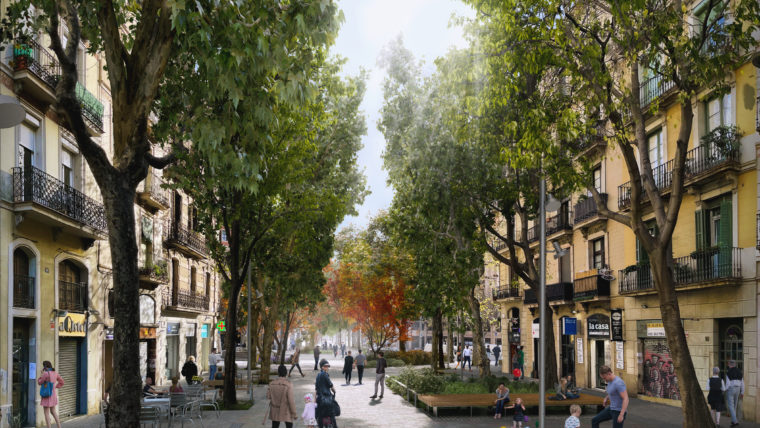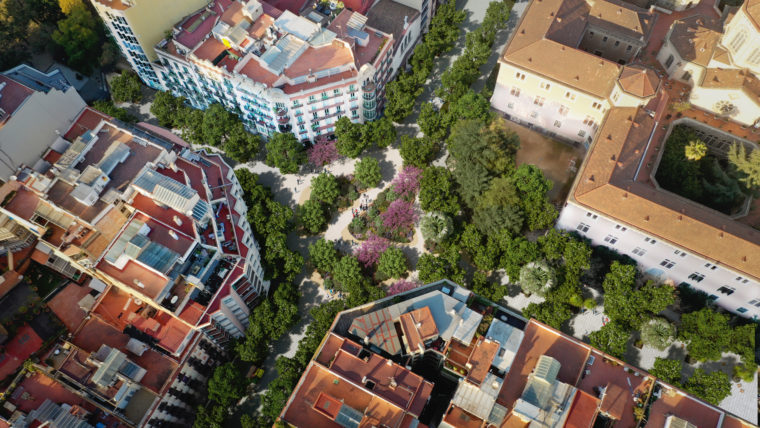All set for the transformation of the Barcelona Superblock in L’Eixample
This summer sees work get under way to transform the central part of the city. The streets of Consell de Cent, Girona, Rocafort and Comte Borrell are to become green streets, with four new squares also created. The transformation will gain 58,000 square metres for pedestrian use, life outdoors, sustainable mobility and sustainable commerce. A media campaign is being launched in July to offer as much information and transparency as possible for the public.
The campaign consists of:
- Information sessions with organisations belonging to the monitoring commissions for the project, open to everybody, as well as specific meetings with local shops and businesses and key groups.
- Information materials in building receptions and areas in the vicinity of the work, information on municipal digital channels and a new Telegram channel which is specific to the work.
- Direct support from information staff who will visit shops and business door to door. As from the end of August and for the duration of the work, commerce and local people will have a direct support channel with an exclusive phone number and email address for doubts and queries.
Changes in mobility
Midway through July, the first stage of transformation work will start to relocate the main services, parking spaces for people with reduced mobility, motorbike parking and Bicing stations and new loading/unloading areas.
Structural work will be carried out simultaneously in the four green streets and four new squares in L’Eixample in August, meaning the following changes (the configuration of mobility will be the same once the work is completed):
- Loading and unloading: zones will be located in streets that intersect the green streets. Where work allows for it, zones will be provided in the green streets themselves.
- Bicycles: bike lanes in the streets of Consell de Cent and Girona will be removed, even though bikes can continue to circulate in the central section in both streets. Alternative bike lanes will be those in València and Gran Via (for the lane in Consell de Cent), and in Roger de Llúria and Pau Claris (for the lane in Girona). This will enable bikes to circulate in the green streets in both directions, in coexistence with pedestrians and all other vehicles.
- Private vehicles: these can reach any point in the green streets, but there will be no continuity of circulation and vehicles will not be able to go through two consecutive sections. When accessing a green street from an intersecting street, once vehicles reach the next corner they will need to exit using the next intersecting street.
- Public transport: no disruptions to bus services or other public transport services in the area.
- Shops: commercial establishments will remain open.
- Reserved entrances and car parks: access guaranteed.
- Pedestrians: pedestrian routes with good visibility will be generated and duly signposted.
- Emergency vehicles and services: access for these vehicles will be completely guaranteed.
Work in each street will be carried out in halves, meaning that the sides nearest the mountain or the sea will not be occupied simultaneously, with only one being occupied so that access is guaranteed for local residents, services, bikes and emergency vehicles.
Towards L’Eixample of the 21st century
The four green streets in L’Eixample correspond to the Barcelona Superblock model, fostering life outdoors, sustainable mobility and local commerce.
- Disappearance of asphalt. A new and more sustainable panot paving stone will be used at building façades and junctions, with granite paving used for the rest of the space.
- More benches, springs and play areas. Rest areas and play areas will be created in each section, streetlights will be lower and located in central parts of the streets, creating a new type of illumination to foster social uses.
- Greenery multiplied by twelve. While only 1% of space in the current streets is given over to greenery, the new design means that figure is to rise to at least 12%. Over 400 trees will be planted, with a greater diversity of species and occupying the central part of the street to gain more foliage and shade. Vegetal subsoil will also mean greater natural wealth and diversity, with water to be reused.
- Vehicles as guests. Vehicles will only be able to circulate at low speeds (10 km/h), and mainly local residents, services and emergency vehicles. The current difference in heights between pavements and road surfaces are to disappear, with curbless paving introduced.
- Promotion of commerce façade to façade, thanks to curbless paving.
- 31 new mini-squares as rest areas and places for children to play in.
The four new squares will all be created as unique spaces. The ones at the junctions in Consell de Cent, with Comte Borrell and with Girona, follow the idea of a more civic, neutral and flexible square. The corresponding junctions with Rocafort and Enric Granados will be more like gardens, where greenery predominates and the space is more conducive to social and leisure uses.
The superilla.barcelona website features a space where users can check all the changes to mobility. The site will be updated every time changes are made.



Further information
Tags associated with the news item
Related news
-
 Mobility and transport
Mobility and transport
Mobility and transport
Mobility and transportWork gets under way on the green streets in L’Eixample: how will mobility change?
10/08/2022 09:31 h




